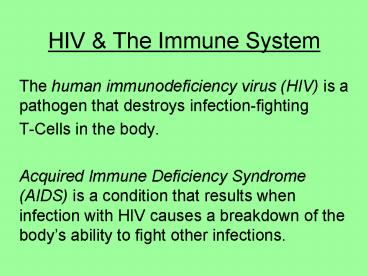HIV - PowerPoint PPT Presentation
1 / 13
Title:
HIV
Description:
HIV & The Immune System The human immunodeficiency virus (HIV) is a pathogen that destroys infection-fighting T-Cells in the body. Acquired Immune Deficiency Syndrome ... – PowerPoint PPT presentation
Number of Views:173
Avg rating:3.0/5.0
Title: HIV
1
HIV The Immune System
- The human immunodeficiency virus (HIV) is a
pathogen that destroys infection-fighting - T-Cells in the body.
- Acquired Immune Deficiency Syndrome (AIDS) is a
condition that results when infection with HIV
causes a breakdown of the bodys ability to fight
other infections.
2
HIV The Immune System (cont.)
- A person is infected with HIV as soon as the
virus enters the blood. The virus attaches itself
to helper-T cells, where it then reproduces its
genetic material. HIV can then take control of
the cell, produce new viral parts, and infect
other cells. When the number of helper-T cells is
lowered, the body has a reduced ability to fight
pathogens, and infections develop.
3
HIV The Immune System (cont.)
- A person is said to have AIDS when his or her
T-Cell count reaches a certain level, when
opportunistic infections and noncommunicable
diseases are present, and when other symptoms
develop. An opportunistic infection is one that
develops in a person with a weak immune system.
Opportunistic infections are difficult to treat
and can cause death in people who have AIDS.
4
How HIV Is Spread
- Blood
- Vaginal secretions
- Semen
- Other body fluids that might contain blood (such
as wound secretions) - Breast milk
5
How HIV Is NOT Spread
- Hugging
- Coughing
- Sharing eating utensils
- Sharing bathroom facilities
- Being bitten by an insect
- Using a telephone or computer
- Kissing
- Sneezing
- Sharing towels or brush/combs
- Sharing a water fountain
- Donating blood
- Swimming in a pool
- Using sports/gym equipment
6
Testing For HIV Infection
- Any person who feels that s/he might have been
exposed to HIV should get tested immediately. Do
not wait for signs or symptoms. Get to a medical
professional ASAP! - When a person becomes infected with HIV, HIV
antibodies typically show up within 3 months
after infection. Almost all people who are
infected with HIV will show antibodies within 6
months.
7
Signs Of HIV AIDS Infection
- The signs of HIV infection might appear right
away or take 12 or more years to occur. These
signs usually include tiredness, fever, swollen
glands, rash, headaches, and flu-like symptoms.
They come and go, depending on the helper T-Cell
count. Even during times when there are no
symptoms, HIV still continues to destroy the
immune system.
8
Signs Of HIV AIDS Infection (cont.)
- Thrush is a fungal infection of the mucous
membranes of the tongue and mouth. White spots
and ulcers cover the infection. Oral hairy
leukoplakia is an infection in which white fuzzy
patches are found on the tongue. Pneumocystis
carinii pneumonia is a form of pneumonia in AIDS
patients. Symptoms include dry cough, fever, and
difficulty breathing.
9
Signs Of HIV AIDS Infection (cont.)
- Kaposis sarcoma causes purple lesions and tumors
on the skin and in the linings of the internal
organs. - AIDS Dementia Complex is a loss of brain function
caused by HIV infection. Symptoms include
forgetfulness, personality changes, and loss of
coordination. The disorder worsens.
10
Treatment For HIV AIDS
- There is no cure for HIV infection or AIDS.
Treatment focuses on making the immune system
strong. AZT is a drug that slows the
multiplication of HIV. DDI is another drug that
slows the multiplication of HIV. These drugs need
to be given a soon as possible after a person
tests HIV-positive. By slowing the multiplication
of HIV, a person will stay healthier longer.
11
Treatment For HIV AIDS (cont.)
- Protease inhibitors are antiviral drugs that
decrease the amount of HIV in the blood and
increase the helper T-Cell count. Protease
inhibitors are newer and more effective against
HIV than some other drugs. Some people who have
used them have had the amount of HIV in the blood
drop to a level where it cannot be detected.
Scientists are still trying to discover where the
HIV hides during this time.
12
Treatment For HIV AIDS (cont.)
- There are other ways to help the immune system.
Some people who are infected with HIV get
transfusions of healthy white blood cells. Some
have bone marrow transplants. Just as important
is good nutrition, reducing stress, and getting
plenty of quality sleep time.
13
Preventing HIV Infection AIDS
- Practice abstinence
- Choose not to use drugs
- Carefully choose your location for any body
piercing or tattoos - Avoid contact with the blood body fluids,
mucous membranes, or broken skin of another
person































